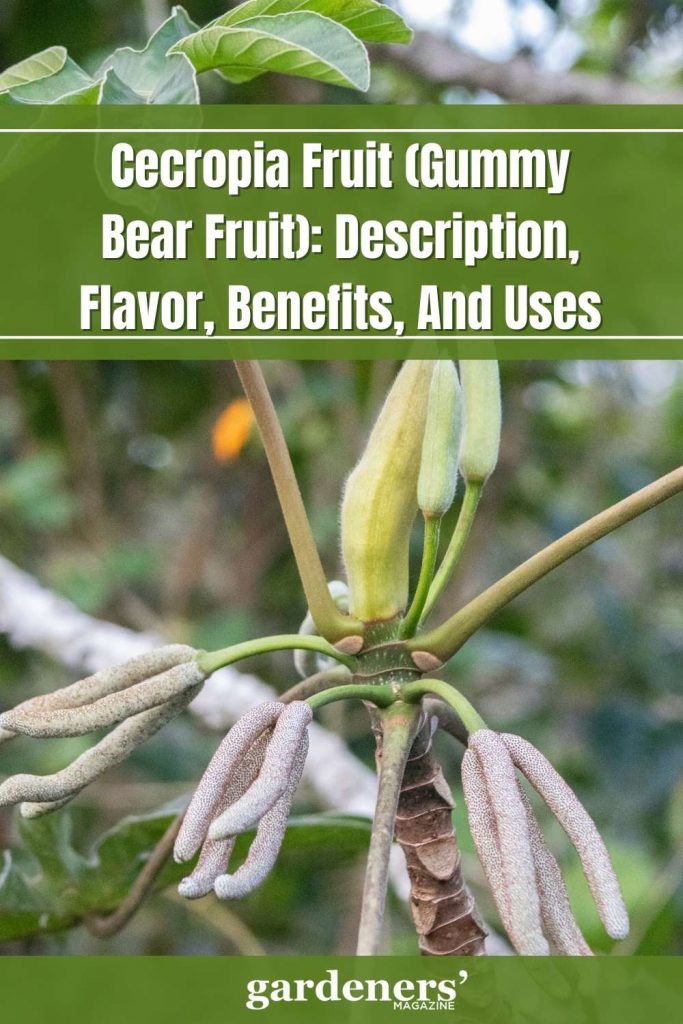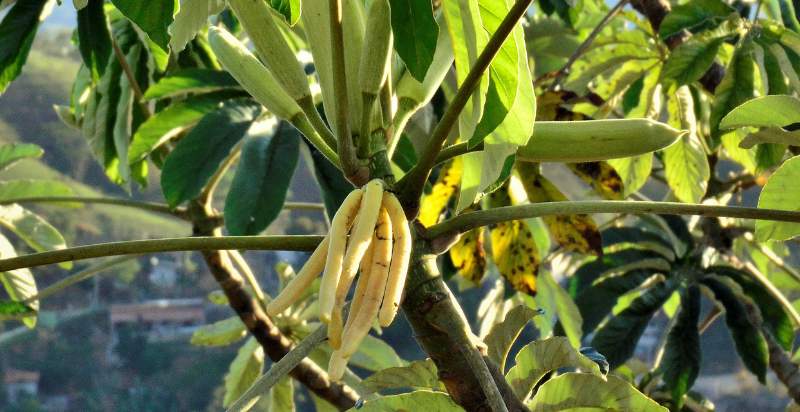Cecropia fruit, or gummy bear fruit, is a unique tropical fruit from the Cecropia tree. The tree grows in tropical rainforests throughout Central and South America, mostly in Brazil and Colombia. Unlike many fruits, the gummy bear fruit has a soft texture with a jelly-like consistency when ripe, hence the name “gummy bear fruit.” Here is everything you need to know about this unique, delicious fruit.
What is Cecropia fruit?
Cecropia fruit, or Gummy Bear Fruit, is a unique tropical fruit in the Amazon rainforest. The tree can grow to over 20 meters tall and comprises large, light green leaves. The fruit itself resembles a large berry with an orange-to-yellow coloration. It has an extremely soft and gelatinous texture, hence its nickname, “gummy bear fruit.”

History and Origin of Cecropia Fruit:
Cecropia is a fruit native to Central and South America. It is an integral part of the traditional diets of many peoples, both in its region of origin and beyond. The fruit has been used for centuries as a food source, medicine, and spiritual offering.
The scientific name for Cecropia is “Cecropia obtusifolia,” it belongs to the Moraceae family, including figs and mulberries. The Cecropia tree can reach up to 40 meters in height and has distinctive palmate leaves with several fingers.
The traditional use of Cecropia dates back centuries. The fruit is often used in the Amazon to treat infections and skin problems. It has also been used as a digestive aid and for weight loss. The tree leaves have even been boiled in water to make an infusion with anti-inflammatory properties.
In some cultures, Cecropia has spiritual significance. In Brazil, for example, it is believed that the fruit has protective powers and is sometimes used in rituals to attract luck. In parts of Colombia, Cecropia leaves are burned as offerings during certain ceremonies.
Appearance and Taste of Cecropia Fruit:
The gummy bear fruit is soft and egg-shaped, with a thin green skin that turns yellow or pink when it ripens. The fruit’s flesh is white with small black seeds, similar to a grapefruit. The taste of the gummy bear fruit is unique – it’s sweet, tart, and slightly acidic.
Nutrition of Cecropia Fruit:
The gummy bear fruit is packed with essential vitamins and minerals. It’s a good source of vitamin C and vitamins B1, B2, B3, calcium, and potassium. It also has small amounts of other nutrients like iron, magnesium, and zinc.
Health Benefits of Cecropia Fruit:
Eating gummy bear fruit can provide a range of health benefits. It’s high in antioxidants which help fight free radicals that can cause disease. The vitamin C content also boosts immunity and keeps the skin healthy. Additionally, potassium helps regulate blood pressure, and calcium helps keep bones strong.
Where to find the Best Quality Cecropia Fruit?
The best place to find the highest quality Cecropia fruit is at local markets or fruit stands specializing in Amazonian produce. These places are known for sourcing only the freshest and most delicious fruits, ensuring customers get the best. Additionally, many online retailers now offer Cecropia fruit shipped directly from farms all over Central and South America, so customers can enjoy the same great quality without leaving home.
How to Store Cecropia fruit?
The best way to store Cecropia fruit is to dry them. To do this, hang the fruits in a well-ventilated area away from direct sunlight for several weeks until completely dry. Once dry, the fruit can be stored at room temperature in an airtight container or bag. The dried Cecropia fruit can last up to 12 months if stored properly.
If you don’t want to dry the Cecropia fruit, it can also be stored in the refrigerator or freezer. Wrap each fruit individually in plastic wrap and store them in the appropriate compartment of your refrigerator or freezer. The fruits should last up to two weeks when stored this way.

How to Use Cecropia fruit in Different Recipes with other Fruits?
Cecropia fruit can be used in various recipes that combine it with other fruits. For example, you can make a simple yet flavorful smoothie by blending Cecropia and mangoes or create a bright and sweet salsa with diced Cecropia and pineapple.
You can add it to yogurt parfaits with granola and other chopped fruits. Other options include making a sweet tart with Cecropia, apples, and cinnamon or baking it in the oven for a decadent crumble. The possibilities are endless for creating recipes that incorporate this delicious fruit.
Conclusion
Cecropia fruit is a delicious and nutritious option used in many different dishes. It’s packed with antioxidants, vitamins, and minerals, as well as being sweet yet tart at the same time. This Amazonian superfood can easily be found at local markets or online retailers, and its shelf life can be extended through either drying or freezing. With its unique flavor and versatile uses, this incredible fruit is worth adding to your diet.
- Everything You Wanted to Know About Red Tamarillos - June 2, 2025
- A Guide to Tulips: Everything You Need to Know & More… - June 2, 2025
- Guanabana: Description, Flavor, Benefits, And Uses - May 27, 2025
